Acoustique Quality Passion Teen monitor loudspeaker by Tim Barrall
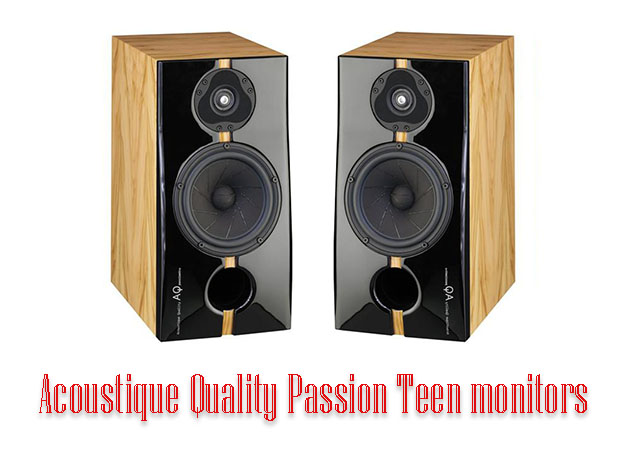
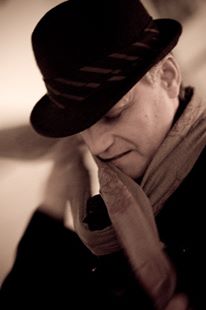 As audiophiles, if we’re passionate enough, we eventually experience some of the best that our hobby has to offer. Being a curious lot, we can’t help but make assumptions about what a speaker might sound like when judging one from looks alone. Will they surprise me? Are they giant killers? Will they add value to my lifestyle? As reviewers at Stereo Times, we’re allowed to audition and write about outstanding products (at least we hope they will be standouts!)
As audiophiles, if we’re passionate enough, we eventually experience some of the best that our hobby has to offer. Being a curious lot, we can’t help but make assumptions about what a speaker might sound like when judging one from looks alone. Will they surprise me? Are they giant killers? Will they add value to my lifestyle? As reviewers at Stereo Times, we’re allowed to audition and write about outstanding products (at least we hope they will be standouts!)
I was fortunate to have been allowed to review this pair of stand-mounted European newcomers, The Acoustique Quality “Passion Teen” monitor (herein Passion Teen). At first glance, you’ll note their styling as exquisite. The cabinet body is made of a beautifully grained solid wood that is perfectly clear coated. Adding to its shiny high gloss finish, the curved baffle has a sensuous note, with 2 speakers and a 3″ round port in its lower front. An attractive contrasting 1.75″ wood strip vertically connects the facial components. The speakers are exposed with no protective grill, which adds to their beauty. On the rear of each Passion Teen are 2 sets of heavy-duty connectors for bi-wire capabilities (the speakers come from the factory with jumpers installed for non-bi-wire use). Each speaker has a weight of around 34 lbs. Dimensions are 8.75″ wide by 17″ high by 14″ deep.
 The AQ Passion Teens’ are the 2-way type – each cabinet includes a 6.5″ driver hand-built by Scan-Speak of Denmark, which handles midrange and bass. Its cone is made of a paper membrane with irregular grooves and filled with damping material, reducing standing waves. Above that is the tweeter. It’s the latest of 1″ Illuminators in which the membrane does not form a spherical cap –The membrane has a partial shape of a toroid. A centrally placed metal Phase plug improves cooling and guarantees outstanding flat frequency response +- 2 dB from 1 kHz to airy 30 kHz. To my eye, it is similar to the look of a jet engine, sleek and aerodynamic in appearance. The suspension is of low-loss rubber SBR designed to handle extreme x-max up to 13mm.
The AQ Passion Teens’ are the 2-way type – each cabinet includes a 6.5″ driver hand-built by Scan-Speak of Denmark, which handles midrange and bass. Its cone is made of a paper membrane with irregular grooves and filled with damping material, reducing standing waves. Above that is the tweeter. It’s the latest of 1″ Illuminators in which the membrane does not form a spherical cap –The membrane has a partial shape of a toroid. A centrally placed metal Phase plug improves cooling and guarantees outstanding flat frequency response +- 2 dB from 1 kHz to airy 30 kHz. To my eye, it is similar to the look of a jet engine, sleek and aerodynamic in appearance. The suspension is of low-loss rubber SBR designed to handle extreme x-max up to 13mm.
The wood cabinet is of a sandwich technology with active BDS damping and non-reflective internal panels. what is BDS? It’s an acronym for “Baffle Diffraction Step.” This is a measurement where a speaker goes from a 2pi hemispherical radiation pattern to a 4pi spherical radiation pattern. It has, in effect, a 6db loss in sound output at lower frequencies – the width of the baffle determines the point at which this occurs that the driver is mounted. The loss occurs over four octaves from the center of it. Go to http://tripp.com.au/sbir.htm and www.aqaudio.cz/en/ for more technical information.
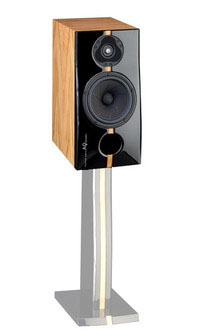
Set-Up
Because of all the zoom calls that pop up so often with our graphic design clients, I had to move my audio rig downstairs to my former listening space, our not yet finished remodel of our lower level (at least the tile flooring is completed!). During the pandemic, our basement flooded, and it’s been under repair ever since, with more than one woodworker backing out of the job to rebuild our cabinetry. Perhaps working on a historic house scares them. As such, there’s not much else in the way of furniture or cabinetry left in that lower space. We hope to find another quality woodworker soon.
Set-Up was pretty straightforward, using a pair of Target stands (24″ tall) I had on hand, my Conrad Johnson gear (both tube and solid-state), and Synergistic cables throughout. I fired up the system and heard what I feared, a very live-sounding room with too many reflections bouncing about, which made me miss my former solid wood floor and the furniture we had that was destroyed. Luckily, I had movers quilts at hand, enough to tack up on the walls, along with a 5×7′ area rug for the floor. This tweak did the trick. I could now proceed with this review. I positioned myself between the speakers while adjusting my ear height equal to the tweeters. I had already put 40 hours or so of “break-in time” on these speakers upstairs.
Listening
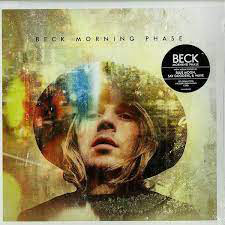 Playing digital files through Amarra software on my MacBook Pro laptop, my first listen was “Morning Phase” from Beck. (2014 Capital/Fonograph). Right from the beginning, this album suggests a gentle modern age sunrise, which put me in an agreeable headspace. The Passion Teens’ responded to Beck’s effort with an enveloping experience. From the foundational bottom end (maybe a bit more bass). The sense of 3D imaging went well beyond the speakers. At this point, things sounded pretty good, but my room could use more sound treatment – (not everyone has a perfect room!) Moving ahead, I selected a track from Bill Frisell’s “Valentine” (Blue Note 2020) album, which is a pretty intimate recording. As usual, the rim shots and cymbals were immediate, and Bill’s guitar chord harmonics were complex. The bass was pretty decent, with a satisfying beef. Again, it brought the sense of 3D forth. Next, up, I choose something from a groovy but not too aggressive group, Friends of Dean Martinez, from their 1995 “Shadow Of Your Smile” album (Sub Pop). This record falls into the lounge category. The Passion Teen’s filled the air with Xylophones, drums, cymbals, guitars, and piano in a cool, relaxing way. The Passion Teen’s work well in the background when you want to lounge about with friends.
Playing digital files through Amarra software on my MacBook Pro laptop, my first listen was “Morning Phase” from Beck. (2014 Capital/Fonograph). Right from the beginning, this album suggests a gentle modern age sunrise, which put me in an agreeable headspace. The Passion Teens’ responded to Beck’s effort with an enveloping experience. From the foundational bottom end (maybe a bit more bass). The sense of 3D imaging went well beyond the speakers. At this point, things sounded pretty good, but my room could use more sound treatment – (not everyone has a perfect room!) Moving ahead, I selected a track from Bill Frisell’s “Valentine” (Blue Note 2020) album, which is a pretty intimate recording. As usual, the rim shots and cymbals were immediate, and Bill’s guitar chord harmonics were complex. The bass was pretty decent, with a satisfying beef. Again, it brought the sense of 3D forth. Next, up, I choose something from a groovy but not too aggressive group, Friends of Dean Martinez, from their 1995 “Shadow Of Your Smile” album (Sub Pop). This record falls into the lounge category. The Passion Teen’s filled the air with Xylophones, drums, cymbals, guitars, and piano in a cool, relaxing way. The Passion Teen’s work well in the background when you want to lounge about with friends.
Now on to vinyl. Linda Ronstadt’s “Lush Life” (Electra/Asylum Records 1984) is part of a 3-LP series done with Nelson Riddle and his orchestra. I bought all three pressings from Tower Records back in the day. With mastering by Doug Sax, these are sonically some of my all-time favorite releases. On the first song, “When I Fall In Love,” the combination of Ronstadt’s voice and Riddle’s orchestra added so much depth and interest that I couldn’t leave my chair. I thought that the Teen’s tweeters were a bit too forward, an opinion my wife, Pam, also held. I trust her ears because she loves hifi too (how many of us can say that?). When we first met, my wife had her rig and vinyl collection; During our many years together, we’ve gone through a few amplifiers, speakers, and turntables.
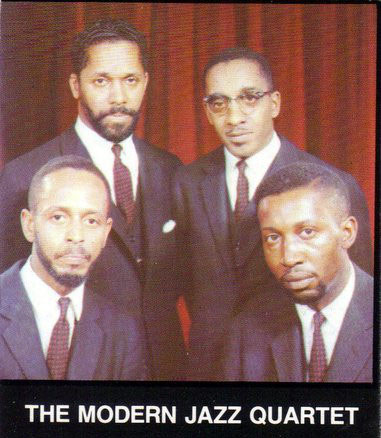 Next up, The Modern Jazz Quartet (Atlantic 1957). Irving Berlin penned the first two songs, They Say It’s Wonderful and How Deep is The Ocean. The vibraphone, bass, drums, and piano will lick your ears. The pacing of these songs is slow and involving, and the Passion Teen’s revealed even more from the grooves. Another jazz favorite of mine is It Don’t Mean A Thing If You Can’t Tap Your Foot To It (Pablo Records 1984). The music is produced very well, and, here, Milt Jackson, Ray Brown, Cedar Walton & Mickey Rocker never sounded better – a sense of transient precision hung on every note.
Next up, The Modern Jazz Quartet (Atlantic 1957). Irving Berlin penned the first two songs, They Say It’s Wonderful and How Deep is The Ocean. The vibraphone, bass, drums, and piano will lick your ears. The pacing of these songs is slow and involving, and the Passion Teen’s revealed even more from the grooves. Another jazz favorite of mine is It Don’t Mean A Thing If You Can’t Tap Your Foot To It (Pablo Records 1984). The music is produced very well, and, here, Milt Jackson, Ray Brown, Cedar Walton & Mickey Rocker never sounded better – a sense of transient precision hung on every note.
Moving on to something more upbeat, I selected a Medeski Martin & Wood release. “MM&W” is an American avant jazz-funk unit formed in 1991. With this spin of Combustication (Blue Note 1998), I loved John Martin’s signature Wurlitzer 7300 Combo Organ work as he weaved through the album’s repertoire. The band’s rhythm section, Billy Martin and Chris Wood added complexity as the hip-hop sounds of “turntablist” DJ Logic brought out another side of jazz. Overall these speakers exceeded my expectations.
Giving some classical a spin, I moved to a favorite, Massenet’s Le Cid Ballet Music performed by The City of Birmingham Symphony Orchestra, conducted by Louis Fremaux (Klavier Records 1973). In my opinion, this is one of the most demanding programs for speakers. (a sidebar: Years ago, my first copy, bought from Acoustic Sounds, slipped from my fingers and fell across the turntable, leaving a big nick. I called Chad Kassem, owner of Acoustic Sounds, and told him of my mishap. He said,” I’ll send you another.” Four days later, I had a new copy in my hands. Love you, Chad). Back to the record; as the needle drops, you must run to your seat and hold on. The first few notes set the tone, but they will catch you off guard! This delightful ballet, Le Cid, was named for Rodrigo de Bivar, a famous Spanish knight and warrior of the twelfth century and an adaption of a tragedy centered upon this legendary hero of Spain. Because of an insult, Le Cid challenges his beloved father to a duel and kills him. The distraught daughter swears vengeance over her dead father, but the lovers are reunited in the end. The Passion Teens excel on classical repertoire, in my opinion. The Passion Teens’ presented the full orchestra and delicate percussion with sonic precision and passion.
Next, Vivaldi Cantatas, Concertos & Magnificat from Emma Kirkby TafelMusik Baroque Orchestra (Hyperion 1987). Everything is perfectly laid back, with just the right amount of bass, mids, and highs. Hmm, maybe I’d go for a bit more bass. I know speaker designers try to deliver an all-around bang for the buck for multiple genres, but, in my opinion, the AQ Passion Teens are made for classical. This thought brought me to my last spin, “Virtuoso Cello Concertos” on Bis, 1983. The string instruments began nicely, and there was an excellent sense of space and air. When the cello came in, I could almost hear the rosin on the bow. The detail was very revealing. Riveted, I listened to the entire album as an enjoyable live concert, sitting in maybe the 6th row back.
Verdict
The AQ Passion Teen’s solid wood construction and high gloss finish, coupled with their tasteful sonics, may very well win your heart after a look and listen. Stands are available that are designed to match. Their 89 dB efficiency certainly makes them easy to drive. They presented a nice dimensionality and clear sound in the presentation. I prefer a touch more bottom end and a bit more roll-off on the tweeters – they were a tad bright for my taste, although your mileage may vary.
My situation at present is unique. I’m sure that a bit of room treatment and furniture would enhance the AQ Passion Teen’s performance and make them a welcomed addition to almost any home.


Tim Barrall
Specifications:
AQ Passion Teen speakers
Price: $6000
Stands available
Contact:
www.aqaudio.cz/en/
Distributor: Boris Meltsner
718-344-2255
sales@ampedamerica.com
ampedamerica.com
Specifications:
Dimensions (W x H x D): 226 x 450 x 360 mm
Weight: 15.5kg, 34.17 lbs.
Internal Volume: 211
impedance: 6ohm
Maximum noise: 70W
Maximum short time: 160W
sensitivity: 89dB/1W/1m
Frequency response: 30 Hz – 45 kHz within 4bB
Crossover slope: 6,6 dB/oct
Tim’s Associated Equipment:
Core Power Technologies Equi=Core 1800 (mains filter)
Audio Path power cord
Kimber Kable “Silver Streak” interconnects
Synergistic Alpha Quad speaker cables
Synergistic kaleidoscope Phase 1 & 2 interconnects
KabelDirekt optical Mini Toslink cable
Conrad Johnson MF200
Conrad Johnson PV8
Living Sounds Audio Warp 1 Amplifier
MacBook Pro 2009
VTI audio rack
Stereo Times Masthead
Publisher/Founder
Clement Perry
Editor
Dave Thomas
Senior Editors
Frank Alles, Mike Girardi, Russell Lichter, Terry London, Moreno Mitchell, Paul Szabady, Bill Wells, Mike Wright, and Stephen Yan,
Current Contributors
David Abramson, Tim Barrall, Dave Allison, Ron Cook, Lewis Dardick, John Hoffman, Dan Secula, Don Shaulis, Greg Simmons, Eric Teh, Greg Voth, Richard Willie, Ed Van Winkle, Rob Dockery, Richard Doron, and Daveed Turek
Site Management Clement Perry
Ad Designer: Martin Perry



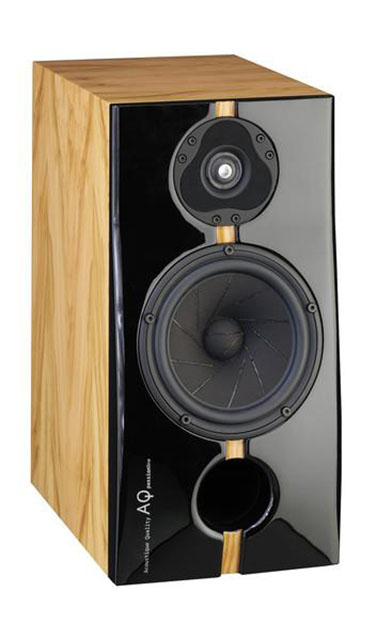





Be the first to comment on: Acoustique Quality Passion Teen monitor loudspeaker by Tim Barrall